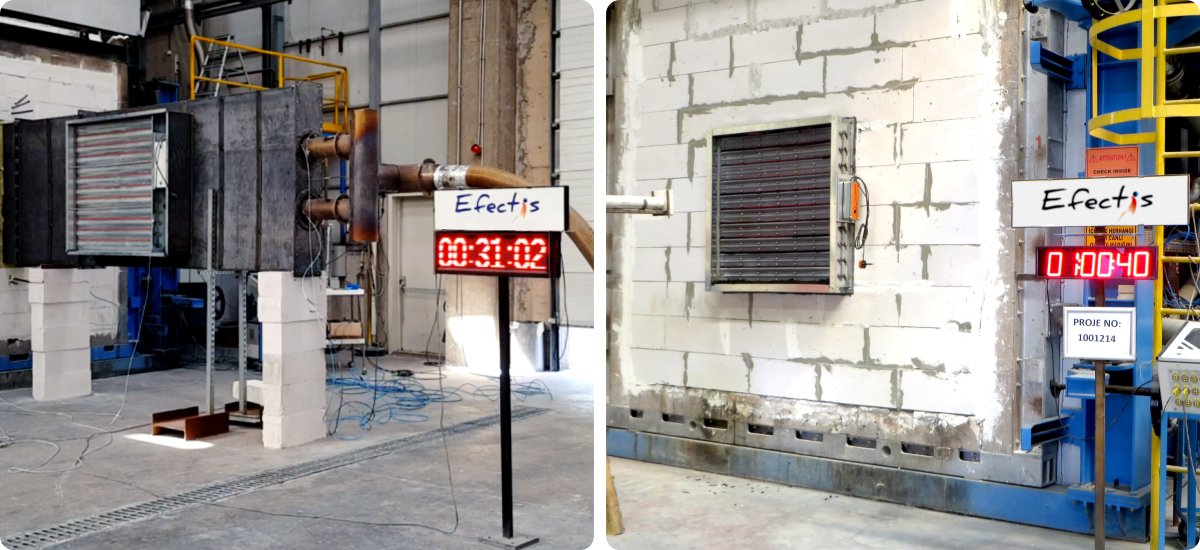13/4/2021
A further fire resistance tests and CE certification have been successfully carried out for fire and smoke control dampers in our furnace according to EN 1366-2, EN 1366-10 and UL 555 standards. CE certification is done within Efectis based on EN 12101-8 and EN 15650 standards. Fire and smoke control dampers essential feature is to satisfy the fire resistance requirements of the fire safety standards for buildings and prevent the passage of fire between the compartments.
EN 1366-2, EN 1366-10 and UL 555 specify methods for determining the fire resistance of fire and smoke dampers installed in fire separating elements designed to withstand heat and the passage of fire, smoke and gases at high temperature. The European Standards are used in conjunction with EN 1363-1.
Performance Criteria for Fire and Smoke Control Dampers based on EN 1366-2 and EN 1366-10:
- Integrity (E): Ability of a test specimen of a separating element of building construction, when exposed to fire on one side, to prevent the passage of flames and hot gases through and to prevent the occurrence of flames on the unexposed side. The leakage through fire damper shall not exceed 360 m3/hm2. There shall not be flaming more than 10 seconds. There shall not be openings (opening with a length of 150 mm for Ø6 mm gap gauge or an opening for Ø25 mm). We apply cotton pad to the openings and there shall not be any flaming on the cotton pad.
- Insulation (I): Insulation is the ability of a component of a service installation to withstand fire exposure without transmission of fire as a result of significant transfer of heat. It is measured whether the thermocouples where located on the surface of the connecting duct on unexposed side exceed the critical temperature value.
- Smoke Leakage (S): Smoke leakage is the ability of the component to resist the passage of gases or smoke at ambient temperature and during exposure to the standard temperature/time test. Throughout the test, the value of under pressure difference in the connecting duct is maintained and measured the leakage value. To gain an S classification to EN 13501-3, the damper shall not exceed 200 m3/m2.h at ambient temperature (corrected to 20 °C) also on the smallest size.
Tests for fire dampers based on UL 555
Fire endurance and hose stream test is applicable for static fire dampers, dynamic fire dampers, combination fire and smoke dampers and corridor dampers.
Performance Criteria for Fire Dampers based on UL 555
- The damper assembly shall remain in the opening during the fire endurance test for the fire-exposure period for which it is to be rated and during the hose stream test.
- Latching mechanisms, blade shafts in their bearings, interlocking-type fire damper blades and blade guides shall remain engaged and secure during the test.
- During the fire exposure, there shall be no flaming of the fire damper assembly materials on the unexposed side.
- The secondary heat response device shall operate, and the fire damper shall completely close and latch automatically (when a latch is provided) when subjected to the fire endurance test.
Classification of fire dampers based on EN 13501-3
| EI | 15 | 20 | 30 | 45 | 60 | 90 | 120 | 180 | 240 |
| E | 30 | 60 |
Classification of smoke control dampers based on EN 13501-4
Multi Compartment fire resisting smoke control dampers
| EI | 30 | 60 | 90 | 120 |
| E | 30 | 60 | 90 | 120 |
Single Compartment smoke control dampers
| E300 | 30 | 60 | 90 | 120 |
| E600 | 30 | 60 | 90 | 120 |
Classification of fire and smoke control dampers based on UL 555
There is no specific classification for UL 555 standards. The test specimen gets the classification of the specific time as long as the specimen resists to fire and provides the performance criteria.

